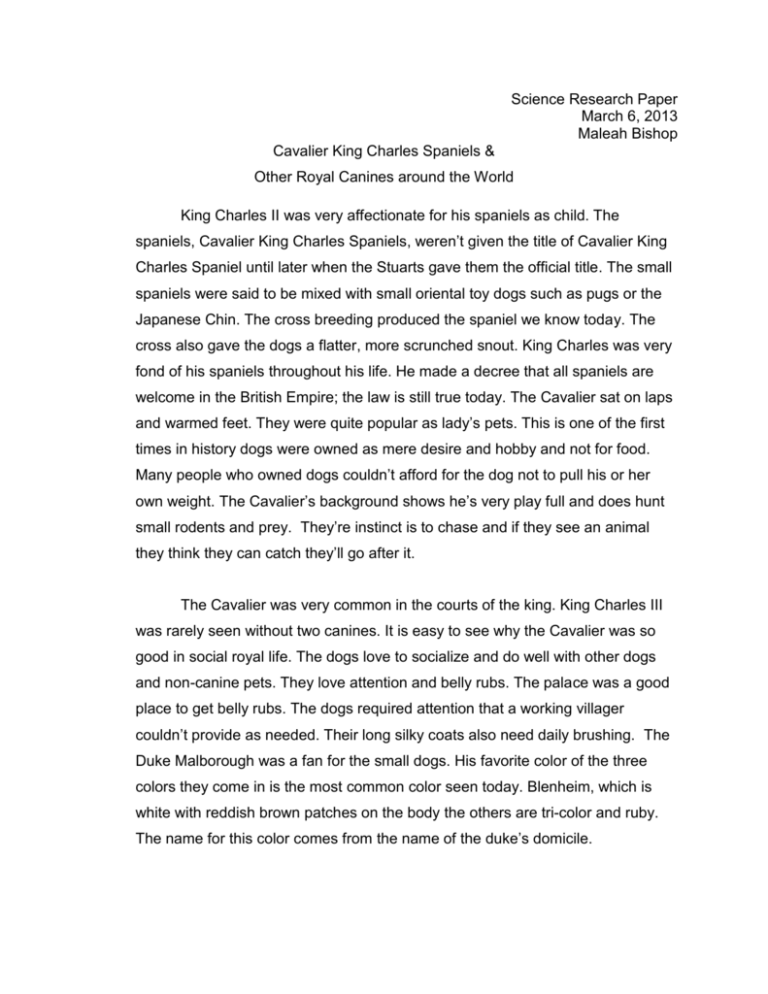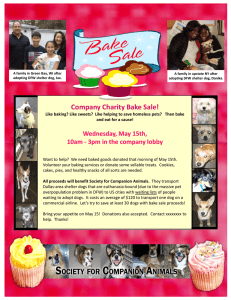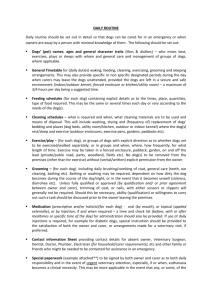Cavalier King Charles Spaniels
advertisement

Science Research Paper March 6, 2013 Maleah Bishop Cavalier King Charles Spaniels & Other Royal Canines around the World King Charles II was very affectionate for his spaniels as child. The spaniels, Cavalier King Charles Spaniels, weren’t given the title of Cavalier King Charles Spaniel until later when the Stuarts gave them the official title. The small spaniels were said to be mixed with small oriental toy dogs such as pugs or the Japanese Chin. The cross breeding produced the spaniel we know today. The cross also gave the dogs a flatter, more scrunched snout. King Charles was very fond of his spaniels throughout his life. He made a decree that all spaniels are welcome in the British Empire; the law is still true today. The Cavalier sat on laps and warmed feet. They were quite popular as lady’s pets. This is one of the first times in history dogs were owned as mere desire and hobby and not for food. Many people who owned dogs couldn’t afford for the dog not to pull his or her own weight. The Cavalier’s background shows he’s very play full and does hunt small rodents and prey. They’re instinct is to chase and if they see an animal they think they can catch they’ll go after it. The Cavalier was very common in the courts of the king. King Charles III was rarely seen without two canines. It is easy to see why the Cavalier was so good in social royal life. The dogs love to socialize and do well with other dogs and non-canine pets. They love attention and belly rubs. The palace was a good place to get belly rubs. The dogs required attention that a working villager couldn’t provide as needed. Their long silky coats also need daily brushing. The Duke Malborough was a fan for the small dogs. His favorite color of the three colors they come in is the most common color seen today. Blenheim, which is white with reddish brown patches on the body the others are tri-color and ruby. The name for this color comes from the name of the duke’s domicile. The longer snout is prized by breeders and judges. Not just because a shorter snout can lead to problems with the nose, it’s the traditional original way the spaniels were. For years after they became popular breeders wanted the shorter snout. Roswell Eldrige saw the older traditional look of the dogs in paintings. There were no Cavaliers like that. Eldrige worked to get the breeders back to the original way, but pet owners wanted the shorter snouts. The breeders would lose business if they bred for the longer snouts. Roswell finally offered money for the Cavalier with the longest snout. The award was given in 1928 the year Roswell died at age seventy. The results were released a month after his death. Other royal treatment and presence of royal pets were common around other parts of Europe 1573-1627. Some royals would treat their canines as their children. The case was that most royal children died at birth, died as a toddler or were born with birth defects. Dogs were good substitutes and sometimes took the place. When royals did have children they were taught by tutors and specialists. Their parents probably spent more time with their dogs than with their children. Elaborate collars made of gold and silver and other precious stone inlaid into them were worn by royal pets and noble’s pets. The collar was not just for fashion, it showed your rank and who you were. Often a noble would have velvet collars all in his colors. Ribbons and earrings were also common at this time. Hunting dogs wore spiked collars. In the nineteenth century, Princess Victoria dressed her dog in blue trousers and a red coat. Paris then started opening up shops selling gold and silver collars and boots for dogs. The store Bouyer & Gotschif opened in 1835. Aux Etats-Unis advertised collars, overcoats and kennels. Then a new hobby for pet owners came in of styling Poodles. Around this time was when competitive dog shows and competitions were made. Princes would line up with their dogs to show. In other parts of the country the dog held a higher stance than known just as the king’s pet. In Turkey to the Kamchatka peninsula, people were found either worshiping the wolf as a god or ancestor. In Greece, Italy the people worshiped the goddess Diana or Artemis, goddess of hunt also called the Wolf Goddess. In many parts of the world the dog is seen with gods or as gods. On the other side of the planet there were also royal Asian canines. Royal dogs included in royal families have been recorded since the Han Dynasty. Sometimes the royal family would ban any dog killings. Emperor Ling Ti gave all his dogs titles. Shang ruler Fu Hao 1250 BC was found with a dog corpse under his own. Popular breeds were Chow Chow, Shih Tzu, Perkinese and the Pug. In the twentieth century Maharajah of Jonagadh’s favorite bitch had royal titles. His dogs rode in rickshaws and wore evening dresses. In some cultures dogs were considered unclean. In others they were sacred or even godly. The Mongolians believed the wolf was sacred. It is said that the great conqueror, Genghis Khan was a descendant from the Grey Wolf and the Doe. Turkic people like the Kazakhs, Uygyrs and Uzbeks think of the gray wolf as the mother of all Turks. The dog’s place in the Mongolian family was more like parents than the status of a child. The dog’s judgment is respected. The dog will decide whether the family will open the door to a stranger or not. One of the most prized gifts one could receive from an emperor was a dog. Empress Tzu His, is China’s most well-known dog lover. She directed her attention to the eunuchs that bred imperial dogs. On her death bed she wrote a poem about the small lion dogs she bred. The poem ended with the lines: And so (the butterfly dog) remains, but if it dies, remember that you too are mortal.



